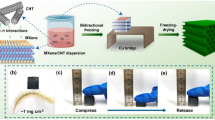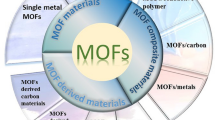Abstract
Ruthenium composites are synthesized by using a sol–gel method with thermally reduced graphene and activation carbon. The specific capacitance of the ruthenium composite with graphene is much higher (440 F g−1) than that of the composite with activated carbon (246 F g−1). The difference is due to the different hydrous and anhydrous ruthenium content of the composites. The activated carbon has micro pores (8.7 Å) with a three-dimensional structure, while the graphene has meso pores (68.9 Å) in a two dimensional structure, resulting that the hydrous ruthenium is likely to be intercalated into graphene rather than the activated carbon. The ruthenium composite with graphene, therefore, has a similar amount of hydrous and anhydrous ruthenium, offering optimized proton and electron paths for electrolyte ions with respect to supercapacitor performance. The composite with activated carbon, however, has more anhydrous ruthenium than the hydrous ruthenium, thereby limiting the proton path. As a result, the ruthenium composite with thermally reduced graphene could provide effective and positive electrodes for supercapacitor applications.





Similar content being viewed by others
References
B.E. Conway, Electrochemical supercapacitor scientific fundamentals and technological applications. (Klumwer Academic/Plenum Publishers, New York, 2010)
M.D. Stoller, S. Park, Y. Zhu, J. An, R.S. Ruoff, Graphene-based ultracapacitors. Nano Lett. 8(10), 3498–3502 (2008). doi:10.1021/nl802558y
C. Liu, Z. Yu, D. Neff, Z. Zhamu, B.Z. Jang, Graphene-based supercapacitor with an ultrahigh energy density. Nano Lett. 10, 4863–4868 (2010). doi:10.1021/nl102661q
E. Frackowiak, F. Beguin, Carbon materials for the electrochemical storage of energy in capacitors. Carbon 39, 937–950 (2001). doi:10.1016/S0008-6223(00)00183-4
M. Inagaki, H. Konnoa, O. Tanaike, Carbon materials for electrochemical capacitors. J. Power Sour. 195, 7880–7903 (2010). doi:10.1016/j.jpowsour.2010.06.036
Y. Zhu, S. Murali, M.D. Stoller et al., Carbon-based supercapacitors produced by activation of graphene. Science 332, 1537–1541 (2011). doi:10.1126/science.1200770
D.A.C. Brownson, D.K. Kampouris, C.E. Banks, Graphene electrochemistry: fundamental concepts through to prominent applications. Chem. Soc. Rev. 41, 6944–6976 (2012). doi:10.1039/c2cs35105f
W. Sugimoto, H. Iwata, K. Yokoshima, Y. Murakami, Y. Takasu, Proton and electron conductivity in hydrous ruthenium oxides evaluated by electrochemical impedance spectroscopy: the origin of large capacitance. J Phys Chem. B 109, 7330–7338 (2005). doi:10.1021/jp044252o
O. Barbieri, M. Hahn, A. Foelske, R. Kotz, Effect of electronic resistance and water content on the performance of RuO2 for supercapacitors. J. Electrochem. Soc. 153(11), A2049–A2054 (2006). doi:10.1149/1.2338633.
W. Sugimoto, K. Yokoshima, Y. Murakami, Y. Takasu, Charge storage mechanism of nanostructured anhydrous and hydrous ruthenium-based oxides. Electrochim. Acta 52, 1742–1748 (2006). doi:10.1016/j.electacta.2006.02.054
H.K. Jeong, Y.P. Lee, R.J.W.E Lahaye et al., Evidence of graphitic AB stacking order of graphite oxides. J. Am. Chem. Soc. 130, 1362–1366 (2008). doi:10.1021/ja076473o
M.H. Tran, H.K. Jeong, Effective reduction of graphene oxide for energy-storage devices. New Phys. 65(3), 240–244 (2015). doi:10.3938/NPSM.65.240
Y. Sato, K. Yomogida, T. Nanaumi, K. Kobayakawa, Y. Ohsawa, M. Kawai, Electrochemical behavior of activated-carbon capacitor materials loaded with ruthenium oxide. Electrochem. Solid State Lett. 3(3), 113–116 (2000). doi:10.1149/1.1390974
J.P. Zheng, C.K. Huang, Electrochemical behavior of amorphous and crystalline ruthenium oxide electrodes. J. New Mater. Electrochem. Syst. 5, 41–46 (2002). doi:10.1142/S0217979202015650
P.G. Collins, Defects and disorder in carbon nanotubes, ed. by A.V. Narlikar, Y.Y. Fu in Oxford handbook of nanoscience and technology: frontiers and advances (Oxford University Press, Oxford, 2009)
S. Letardi, M. Celino, F. Cleri, V. Rosato, Atomic hydrogen adsorption on a stone-wales defect in graphite. Surf. Sci. 496, 33–38 (2002). doi:10.1016/S0039-6028(01)01437-6
F. Banhart, J. Kotakoski, A.V. Krasheninnikov, Structural defects in graphene. ACS Nano 5(1), 26–41 (2011). doi:10.1021/nn102598m
H. Kim, B. Popov, Characterization of hydrous ruthenium oxide/carbon nanocomposite supercapacitors prepared by a colloidal method. J. Power Sour. 104, 52–61 (2002). doi:10.1016/S0378-7753(01)00903-X
Moulder JF, Stickle WF, Sobol PE and Bomben KD, Handbook of X-ray photoelectron spectroscopy. (Perkin Elmer Cooperation, Eden Prairie, 1992)
Hien N.T.B., Kim H.Y., Yeon M. et al., Ru–N–C hybrid nanocomposite for ammonia dehydrogenation: influence of n-doping on catalytic activity. Materials 8, 3442–3455 (2015). doi:10.3390/ma8063442.
D. Rochefort, P. Dabo, D. Guay, P.M.A. Sherwood, XPS investigations of thermally prepared RuO2 electrodes in reductive conditions. Electrochim. Acta 48, 4246–4252 (2003). doi:10.1016/S0013-4686(03)00611-X
C. Mun, J.J. Ehrhardt, L. Lambert, C. Madic, XPS investigations of ruthenium deposited onto representative inner surfaces of nuclear reactor containment building. Appl. Surf. Sci. 253, 7613–7621 (2007). doi:10.1016/j.apsusc.2007.03.071
S. Barison, D. Barreca, S. Daolio, M. Fabrizio, E. Tondello, Influence of electrochemical processing on the composition and microstructure of chemical-vapor deposited Ru and RuO2 nanocrystalline films. J Mater. Chem. 12, 1511–1518 (2002). doi:10.1039/B110611M
M.J. Gladys, A. Mikkelsen, J.N. Andersen, G. Held, Water adsorption on O-covered Ru{0001}: coverage-dependent change from dissociation to molecular adsorption. Chem. Phys. Lett. 414, 311–315 (2005). doi:10.1016/j.cplett.2005.08.077
G. Socrates, Infrared and Raman characteristic group frequencies, 3rd edn. (Wiley, New York, 2001)
M.H. Tran, J. Han, B.J. Min, C.W. Lee, S.H. Jang, H.K. Jeong, Effect of amino acid immobilization on the impedance of graphene oxide. Chem Phys Lett. 627, 130–133 (2015). doi:10.1016/j.cplett.2015.03.053.
D.A. Dornbusch, R. Hilton, M.J. Gordon, G.J. Suppes, Effects of Sonication on EIS Results for Zinc Alkaline Batteries. ECS Electrochem. Lett. 2(9), A89–A92 (2013). doi:10.1149/2.006309eel
Acknowledgements
This research was supported by the Daegu University Research Grant, 2014.
Author information
Authors and Affiliations
Corresponding author
Rights and permissions
About this article
Cite this article
Tran, MH., Jeong, H.K. Comparison of ruthenium composites with thermally reduced graphene and activated carbon for supercapacitor applications. J Mater Sci: Mater Electron 28, 7969–7975 (2017). https://doi.org/10.1007/s10854-017-6500-y
Received:
Accepted:
Published:
Issue Date:
DOI: https://doi.org/10.1007/s10854-017-6500-y




